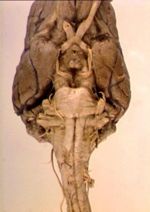Difference between revisions of "Cranial Nerves - Anatomy & Physiology"
(New page: {{unfinished}} {{toplink |linkpage =Nervous and Special Senses - Anatomy & Physiology |linktext =Nervous and Special Senses |maplink = Nervous System and Special Senses (Content Map) - Ana...) |
|||
| Line 193: | Line 193: | ||
| − | '''[[ | + | '''[[Eye - Anatomy & Physiology|Vision]]''' '''SSS''' |
Occipital cortex —→ Thalamus MGN —→ Rostral colliculus/Retinal ganglion cell —→ Bipolar cell —→ '''VISION''' | Occipital cortex —→ Thalamus MGN —→ Rostral colliculus/Retinal ganglion cell —→ Bipolar cell —→ '''VISION''' | ||
Revision as of 14:44, 14 August 2009
| This article is still under construction. |
|
|
Cranial nerves are those nerves which arise from the brain and brain stem rather than the spinal cord. Nerves arising from the spinal cord are the peripheral nerves. There are 12 cranial nerves, although the trigeminal nerve (V) has 3 branches. These are:
Opthalmic (V1)
Maxillary (V2)
Mandibular (V3)
A summary of the cranial nerves is shown below:
| Nerve | Attatchment to brain | Exit Foramen | Fibre Type | Location of cell bodies | Distribution |
|---|---|---|---|---|---|
| I - Occulomotor | Olfactory bulb | Cribriform plate | SVS | Olfactory epithelium | Olfactory epithelium |
| II - Optic | Optic chiasma | Optic canal | SSS | Retina | Retina |
| III - Occulomotor | Midbrain | Orbital fissure and Round Foramen | GSM + GVM | Nuculi III
parasympathetic nuculi III |
Extraoccular mm.
Constrictor pupulli |
| IV - Trochlear | Midbrain (dorsal) | Round Foramen | GSM | Nuc IV | Dorsal oblique mm. |
| V - Trigeminal | Pons | V1 - Orbital fissure
V2 - Round Foramen and Orbital Fissure V3 - Oval Foramen |
V1 - GSS
V2 - GSS V3 - SVM |
V1 - Trigeminal gangion
V2 - Trigeminal ganglion V3 - Nuculi V |
V1 - Eye region
V2 - Upper jaw inc. teeth V3 - mm. of arch 1 |
| VI - Abducens | Medulla oblongata | Orbital fissure | GSM | Nuc IV | Dorsal oblique mm. |
| VII - Facial | Medulla oblongata | Stylomastoid foramen | SVM + GVM + SVS | Nuc III
(Taste - gleniailate ganglion) |
mm. of arch 2
Submaxillary and sublingual glands Rostral 2/3 taste |
| VIII - Vestibulocochlear | Medulla oblongata | Inner accoustic meatus | SSS | Vestibular ganglion | Maculae and cristae |
| IX - Glossopharyngeal | Medulla oblongata | Jugular foramen | G/S V M/S | Ganglia IX - SVM
Nuculi ambiguous - mm. arch 3 |
Carotid gland
Caudal 1/3 taste mm. of arch 3 Carotid body |
| X - Vagus | Medulla oblongata | Jugular foramen | GVM + SUM + GVS + GSS | Ganglion X - (amongst others) | Thoracic and abdominal organs
mm. of arches 4-6 Pharynx and larynx External ear |
| XI - Accessory | Medulla oblongata | Jugular foramen | GSM | Cervical spinal cord | Trapezius m. etc |
| XII - Hypoglossal | Medulla oblongata | Hypoglossal canal | GSM | Medulla nuculi XII | Tongue mm. |
Cranial Nerve Fibre Types
Cranial nerves are best explained by function:
- General Somatic Motor (GSM)
Motor cortex —→ Motor nuculi —→ Muscle
- General Visceral Motor (GVM)
Brainstem —→ Parasympathetic nuculi —→ Parasympathetic ganglion —→ Gland etc
- "Branchial motor" - Special Visceral Motor (SVM)
Motor cortex —→ Motor nuculi —→ Muscle
- General Somatic Sensory (GSS) and General Visceral Sensory (GVS)
Sensory cortex —→ Thalamus —→ Trigeminal nuculi —→ Trigeminal ganglion —→ Skin etc
Special sensory fibres (SSS + SVS):
Smell SVS
Priform cortex —→ Olfactory tubercle —→ Olfactory Bulb —→ SMELL
Vision SSS
Occipital cortex —→ Thalamus MGN —→ Rostral colliculus/Retinal ganglion cell —→ Bipolar cell —→ VISION
Hearing/Balance SSS
Temporal cortex —→ Thalamus MGN —→ Caudal colliculus and hindbrain —→ Spiral ganglion —→ HEARING
Taste SVS
Sensory cortex —→ Thalamus —→ Hindbrain (VII, IX, X) —→ Ganglion —→ TASTE
